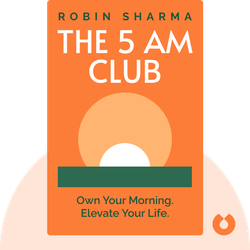Try Blinkist to get the key ideas from 7,000+ bestselling nonfiction titles and podcasts. Listen or read in just 15 minutes.
Start your free trial
Blink 3 of 8 - The 5 AM Club
by Robin Sharma

A New Way to Partner for Innovation and Growth
The Reciprocity Advantage by Bob Johansen and Karl Ronn is a guide to help businesses succeed by focusing on creating value for customers, partners and stakeholders. It outlines how giving can lead to success in a competitive environment.
Have you got a basement full of junk that you scarcely touch? Many companies have a figurative basement full of assets that go unused. But just because something isn’t used, doesn’t mean it’s useless! The stuff in the figurative basement, or unutilized assets, may hold great possibilities for creating new, mutually beneficial partnerships.
IBM is an outstanding example of this. As personal computers shrank in size in the mid1980s, IBM struggled to keep its bigger computers relevant in the market. To address this challenge, the company looked at what else it could offer, and realized that over the years it had built up a lot of in-house competence in managing and analyzing data: an underutilized asset. So instead of falling behind the times, IBM used this know-how as a base for new products and services, helping companies manage and analyze large data sets.
Today, IBM partners with governments, agencies and companies to create solutions that their clients wouldn’t be able to come up with otherwise, such as redistributing traffic flow for improved travel within the city of Istanbul.
And their service-oriented approach is highly profitable. In 2000, IBM’s profits from software were $2.6 billion, with $3.3 billion in hardware. But by 2012, their software profits had soared to $10.8 billion, while hardware showed very little growth. What if IBM had never thought of turning to services?
Learn from IBM: sometimes admitting defeat in one area can lead to a new, more productive path in your business. In this way, even enemies can become good partners. Take Microsoft’s Kinect, a gaming platform that used sensors to track body movement. Shortly after its launch in 2010, the platform was hacked. Microsoft fought back at first but after realizing it was futile, the company decided to partner with the hackers and open up the platform for anyone to modify.
The technology, initially meant only for gaming, has now spawned a wide range of applications, and the software development kit for Kinect has been downloaded millions of times all over the world. Microsoft could not have gained such a wide reach without its hacker partners.



Big changes are coming to the way we live and do business. The Reciprocity Advantage describes the global trends that will disrupt current business partnership models, and explains how you can build advantageous collaborations that’ll stand the test of time. These blinks will equip you with the knowledge you need to succeed in the business world of the future.
The Reciprocity Advantage (2014) is a thought-provoking book that explores the power of reciprocal relationships in business and how they can create a competitive advantage. Here's why this book is worth reading:
It is one thing to be hungry and hopeless, but it is quite another to be hungry, hopeless and connected.

It's highly addictive to get core insights on personally relevant topics without repetition or triviality. Added to that the apps ability to suggest kindred interests opens up a foundation of knowledge.
Great app. Good selection of book summaries you can read or listen to while commuting. Instead of scrolling through your social media news feed, this is a much better way to spend your spare time in my opinion.
Life changing. The concept of being able to grasp a book's main point in such a short time truly opens multiple opportunities to grow every area of your life at a faster rate.
Great app. Addicting. Perfect for wait times, morning coffee, evening before bed. Extremely well written, thorough, easy to use.
Try Blinkist to get the key ideas from 7,000+ bestselling nonfiction titles and podcasts. Listen or read in just 15 minutes.
Start your free trial
Blink 3 of 8 - The 5 AM Club
by Robin Sharma
What is the main message of The Reciprocity Advantage?
The main message of The Reciprocity Advantage is the power of reciprocity in creating successful collaborations.
How long does it take to read The Reciprocity Advantage?
The reading time for The Reciprocity Advantage varies, but it typically takes several hours. The Blinkist summary can be read in just 15 minutes.
Is The Reciprocity Advantage a good book? Is it worth reading?
The Reciprocity Advantage is worth reading because it provides valuable insights and strategies for building mutually beneficial partnerships.
Who is the author of The Reciprocity Advantage?
The author of The Reciprocity Advantage is Bob Johansen and Karl Ronn.